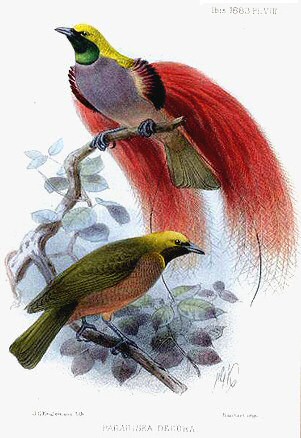|
Evolvability
Evolvability is defined as the capacity of a system for adaptive evolution. Evolvability is the ability of a population of organisms to not merely generate genetic diversity, but to generate '' adaptive'' genetic diversity, and thereby evolve through natural selection. In order for a biological organism to evolve by natural selection, there must be a certain minimum probability that new, heritable variants are beneficial. Random mutations, unless they occur in DNA sequences with no function, are expected to be mostly detrimental. Beneficial mutations are always rare, but if they are too rare, then adaptation cannot occur. Early failed efforts to evolve computer programs by random mutation and selection showed that evolvability is not a given, but depends on the representation of the program as a data structure, because this determines how changes in the program map to changes in its behavior. Analogously, the evolvability of organisms depends on their genotype–phenotype map. T ... [...More Info...] [...Related Items...] OR: [Wikipedia] [Google] [Baidu] |
Andreas Wagner
Andreas Wagner (born 26 January 1967) is an Austrian/US Evolutionary biology, evolutionary biologist and professor at the University of Zürich, Switzerland. He is known for his work on the role of Robustness (evolution), robustness and key innovation, innovation in biological evolution. Wagner is professor and chairman at the Department of Evolutionary Biology and Environmental Studies at the University of Zürich. Biography Wagner studied biology at the University of Vienna. He received his Ph.D. at Yale University, Department of Biology in 1995. He also holds a M. Phil. from Yale. From 1995 to 1996 he was a fellow at the Institute for Advanced Study Berlin, Germany. From 1998 to 2002 he was assistant professor at the University of New Mexico, Department of Biology and from 2002 to 2012 associate professor (with tenure) at the University of New Mexico, Department of Biology. He was appointed professor at the University of Zürich, Institute of Biochemistry in 2006. In 2011, h ... [...More Info...] [...Related Items...] OR: [Wikipedia] [Google] [Baidu] |
Genetic Architecture
Genetic architecture is the underlying genetic basis of a phenotypic trait and its variational properties. Phenotypic variation for quantitative traits is, at the most basic level, the result of the segregation of alleles at quantitative trait loci (QTL). Environmental factors and other external influences can also play a role in phenotypic variation. Genetic architecture is a broad term that can be described for any given individual based on information regarding gene and allele number, the distribution of allelic and mutational effects, and patterns of pleiotropy, dominance, and epistasis. There are several different experimental views of genetic architecture. Some researchers recognize that the interplay of various genetic mechanisms is incredibly complex, but believe that these mechanisms can be averaged and treated, more or less, like statistical noise. Other researchers claim that each and every gene interaction is significant and that it is necessary to measure and model ... [...More Info...] [...Related Items...] OR: [Wikipedia] [Google] [Baidu] |
Adaptation
In biology, adaptation has three related meanings. Firstly, it is the dynamic evolutionary process of natural selection that fits organisms to their environment, enhancing their evolutionary fitness. Secondly, it is a state reached by the population during that process. Thirdly, it is a phenotypic trait or adaptive trait, with a functional role in each individual organism, that is maintained and has evolved through natural selection. Historically, adaptation has been described from the time of the ancient Greek philosophers such as Empedocles and Aristotle. In 18th and 19th-century natural theology, adaptation was taken as evidence for the existence of a deity. Charles Darwin and Alfred Russel Wallace proposed instead that it was explained by natural selection. Adaptation is related to biological fitness, which governs the rate of evolution as measured by changes in allele frequencies. Often, two or more species co-adapt and co-evolve as they develop adaptations tha ... [...More Info...] [...Related Items...] OR: [Wikipedia] [Google] [Baidu] |
Evolutionary Capacitance
Evolutionary capacitance is the storage and release of variation, just as electric capacitors store and release charge. Living systems are robust to mutations. This means that living systems accumulate genetic variation without the variation having a phenotypic effect. But when the system is disturbed (perhaps by stress), robustness breaks down, and the variation has phenotypic effects and is subject to the full force of natural selection. An evolutionary capacitor is a molecular switch mechanism that can "toggle" genetic variation between hidden and revealed states. If some subset of newly revealed variation is adaptive, it becomes fixed by genetic assimilation. After that, the rest of variation, most of which is presumably deleterious, can be switched off, leaving the population with a newly evolved advantageous trait, but no long-term handicap. For evolutionary capacitance to increase evolvability in this way, the switching rate should not be faster than the timescale of geneti ... [...More Info...] [...Related Items...] OR: [Wikipedia] [Google] [Baidu] |
Outcrossing
Out-crossing or out-breeding is the technique of crossing between different breeds. This is the practice of introducing distantly related genetic material into a breeding line, thereby increasing genetic diversity. Outcrossing in animals Outcrossing can be a useful technique in animal breeding. The outcrossing breeder intends to remove the traits by using "new blood." With dominant traits, one can still see the expression of the traits and can remove those traits, whether one outcrosses, line breeds or inbreeds. With recessive traits, outcrossing allows for the recessive traits to migrate across a population. Many traits are Mendelian and therefore exhibit a more complicated intermediate phenotype. The outcrossing breeder then may have individuals that have many deleterious genes that may be expressed by subsequent inbreeding. There is now a gamut of deleterious genes within each individual in many dog breeds. Increasing the variation of genes or alleles within the gene poo ... [...More Info...] [...Related Items...] OR: [Wikipedia] [Google] [Baidu] |
Inbreeding
Inbreeding is the production of offspring from the mating or breeding of individuals or organisms that are closely genetic distance, related genetically. By analogy, the term is used in human reproduction, but more commonly refers to the genetic disorders and other consequences that may arise from expression of wikt:deleterious, deleterious dominance (genetics), recessive traits resulting from incestuous sexual relationships and consanguinity. Animals avoid inbreeding only rarely. Inbreeding results in homozygous, homozygosity which can increase the chances of offspring being affected by recessive phenotypic trait, traits. In extreme cases, this usually leads to at least temporarily decreased Fitness (biology), biological fitness of a population (called inbreeding depression), which is its ability to survive and reproduce. An individual who inherits such deleterious traits is colloquially referred to as ''inbred''. The avoidance of expression of such deleterious recessive allel ... [...More Info...] [...Related Items...] OR: [Wikipedia] [Google] [Baidu] |
Biological Dispersal
Biological dispersal refers to both the movement of individuals (animals, plants, fungi, bacteria, etc.) from their birth site to their breeding site ('natal dispersal') and the movement from one breeding site to another ('breeding dispersal'). Dispersal is also used to describe the movement of propagules such as seeds and spores. Technically, dispersal is defined as any movement that has the potential to lead to gene flow. The act of dispersal involves three phases: departure, transfer, and settlement. There are different fitness costs and benefits associated with each of these phases. Through simply moving from one habitat patch to another, the dispersal of an individual has consequences not only for individual fitness, but also for population dynamics, population genetics, and species distribution. Understanding dispersal and the consequences, both for evolutionary strategies at a species level and for processes at an ecosystem level, requires understanding on the type of ... [...More Info...] [...Related Items...] OR: [Wikipedia] [Google] [Baidu] |
Selection Coefficient
Selection coefficient, usually denoted by the letter ''s'', is a measure used in population genetics to quantify the relative fitness of a genotype compared to other genotypes. Selection coefficients are central to the quantitative description of evolution, since fitness differences determine the change in genotype frequencies attributable to selection Selection may refer to: Science * Selection (biology), also called natural selection, selection in evolution ** Sex selection, in genetics ** Mate selection, in mating ** Sexual selection in humans, in human sexuality ** Human mating strat .... The selection coefficient is typically calculated using fitness values. The fitness (W) of a genotype is a measure of its reproductive success, often expressed as a fraction of the maximum reproductive success in the population. The formula to calculate the selection coefficient s for a genotype is: s = 1 - W, where W is the relative fitness of the genotype, ranging between 0 and 1. ... [...More Info...] [...Related Items...] OR: [Wikipedia] [Google] [Baidu] |
Sexual Selection
Sexual selection is a mechanism of evolution in which members of one sex mate choice, choose mates of the other sex to mating, mate with (intersexual selection), and compete with members of the same sex for access to members of the opposite sex (intrasexual selection). These two forms of selection mean that some individuals have greater reproductive success than others within a population, for example because they are more Animal sexual behaviour, attractive or prefer more attractive partners to produce offspring. Successful males benefit from frequent mating and monopolizing access to one or more fertile females. Females can maximise the return on the energy they invest in reproduction by selecting and mating with the best males. The concept was first articulated by Charles Darwin who wrote of a "second agency" other than natural selection, in which competition between mate candidates could lead to speciation. The theory was given a mathematical basis by Ronald Fisher in the e ... [...More Info...] [...Related Items...] OR: [Wikipedia] [Google] [Baidu] |
Effective Population Size
The effective population size (''N''''e'') is the size of an idealised population that would experience the same rate of genetic drift as the real population. Idealised populations are those following simple one- locus models that comply with assumptions of the neutral theory of molecular evolution. The effective population size is normally smaller than the census population size ''N'', partly because chance events prevent some individuals from breeding, and partly due to background selection and genetic hitchhiking. The same real population could have a different effective population size for different properties of interest, such as genetic drift (or more precisely, the speed of coalescence) over one generation vs. over many generations. Within a species, areas of the genome that have more genes and/or less genetic recombination tend to have lower effective population sizes, because of the effects of selection at linked sites. In a population with selection at many loci an ... [...More Info...] [...Related Items...] OR: [Wikipedia] [Google] [Baidu] |





